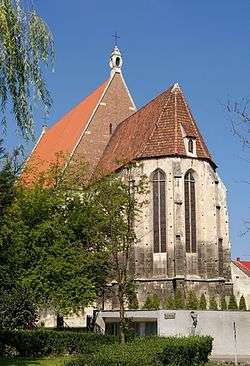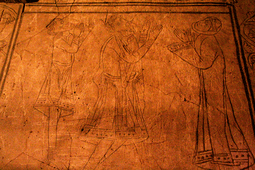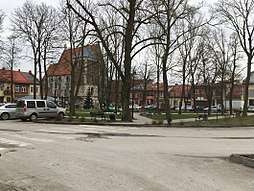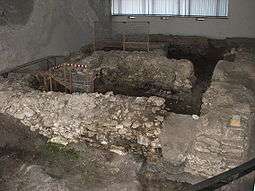Wiślica
Wiślica [viˈɕlit͡sa] is a town in Busko County, Świętokrzyskie Voivodeship, in south-central Poland. It is the seat of the gmina (administrative district) called Gmina Wiślica. It lies on the Nida River, approximately 14 kilometres (9 mi) south of Busko-Zdrój and 60 km (37 mi) south of the regional capital Kielce.[1] In 2016 the town had a population of 503. It was the smallest town in Poland in 2018.
Wiślica | |
|---|---|
Town | |
 Collegiate Basilica of the Birth of the Blessed Virgin Mary in Wiślica | |
 Coat of arms | |
 Wiślica | |
| Coordinates: 50°20′48″N 20°40′25″E | |
| Country | |
| Voivodeship | Świętokrzyskie |
| County | Busko |
| Gmina | Wiślica |
| Population | |
| • Total | 503 |
| Website | http://www.ug.wislica.pl/ |






History
Wiślica is one of the most ancient settlements in Poland, and has played an important role in Polish history. The town was founded more than 1000 years ago, close to the important commercial routes, running from Kraków to Sandomierz. At that time it was probably the capital of the famous tribe Vistulans. The land of Vistulans, after coming under temporary rule of Great Moravian and Bohemia, was incorporated into Poland by Mieszko I in 990. The first guarded settlement was probably founded at the end of the 9th century. The remains that survive today are of the settlement which was erected at the end of the 12th century. The city had regular streets, the well was inlaid with stones, and a water cistern and the remains of 47 wooden houses have been found. The area compromised ten sub-settlements, whose inhabitants worked for the needs of the city. It is very likely that the city was burnt down by Tatars during the famous invasion of 1241 and it was never again inhabited by settlers.
In the late 1950s, archaeologists discovered the foundations of the St. Nicholas church, dating back to the 10th or 11th century, which is exposed at the museum pavilion. The church was small: 6.65 m long and 3.40 m. wide, with one aisle, and a semicircular apse. It is one of the oldest churches in market settlements of the Małopolska region.
The famous gypsum baptismal font located under the foundation of the church became a scientific sensation and the subject of heated discussions after its discovery. Probably it was served as a font for collective baptising in the 9th century. If so, it would be the place of the earliest baptism on Polish grounds. This event is mentioned in Life of st. Methodius as, so-called Pannonian Legend.
In the 12th century, Wiślica became an important centre of court, intellectual and political life. It was given the status of the outstanding cultural centre by the wife of the prince Casimir the Just. In the years 1166–1173 the town was the capital of the duchy of Wiślica. This is probably when the truly royal, unique in Poland, residential complex consisting of two big palaces and the additional round chapels was erected. Also, another church was founded. Its remains are hidden in Basilica vaults among the relicts of third Wiślica's sanctuary. Their discoveries turned out to be a great sensation, especially the floor of the burial crypt of the first Romanesque church built in this place around 1170. It is the priceless work of the art and monument of Romanesque style.
Located in the burial crypt of the 12th-century church, so-called Slab of Orants is a gypsum panel with engravings filled with black paste mixed with charcoal. It's showing two fields with plain figures separated and surrounded by decorated strips fringes, showing mythological creatures: griffins, a female centaur and the tree of life. Probably the figures represents prince Henry of Sandomierz and Kazimir the Just with their families. It is also a burial place of Henry of Sandomierz. The church with Slab of Orants was replaced in the 13th century by bigger, three-aisled basilica. Its remains are still visible in the vaults and are represented by decorative ceramic floor.
Around half of 14th century, another church was erected by the king Casimir the Great. It is a beautiful example of the Gothic style in architecture while the most precious buildings of its kind in southern Poland. Also, it is the finest example of very rare two-aisled type churches. The Basilica interior is richly decorated by precious and unique wall paintings. They were commissioned around 1400 by the king Vladislau Jagiello in his favourite Ruthenian-Byzantine style. Next to the basilica two buildings founded by Jan Długosz has been preserved. In 1442 he became a cantor in the Wiślica church and two years later its curator. Around 1460 he founded the belfry and a building for 12 canons and 12 assistant curates, which is today a rare monument of medieval residential architecture.
Wiślica was granted charter rights by the king Władysław I the Elbow-high in 1326. Since this time it was a place of frequent political gatherings, as well as the place of reading out of Wiślica Statutes. His son, King Casimir the Great built the towns fortified walls with three gates and the castle which was later pulled down. The town's spacious layout changed in those years. The new center of Wiślica was located on the commercial route, so-called Via Salis. New bridges on the river Nida were constructed. Wiślica was granted important privileges, toll customs on the bridges, the exemption of townspeople custom duties and the right of storing salt. The brewery of Wiślica was known as producing the excellent beer, which was delivered to Kraków for the royal table.
From the 14th century Wiślica was the capital of a land, from the 15th century it was a county capital and the seat of starosta. In 1528 king Sigismund I the Old granted Wiślica the right to build municipal waterworks. By the end of the 16th century, the town was destroyed by successive fires, floods and epidemic, began to fall into the oblivion. The towns ultimate destruction took place in 1657 during the Swedish Deluge. Although Wiślica remained the county capital until the end of the 18th century, it never regained its previous splendour. In 1795 it became part of Austria as a result of the Third Partition of Poland.
From 1809 it was in the Duchy of Warsaw, then from 1815 in the Congress Poland under Russian rule, and again in independent Poland since 1918. Wiślica lost its city charter in 1870, and it was again destroyed in the course of the First World War, in 1915.
In 1939 during the Invasion of Poland heavy fighting occurred near the village. In the course of the German occupation that followed, Wiślica's Jewish community perished in The Holocaust. Unfortunately, today Wiślica is still forgotten and marginalised by bigger intellectual centres, but remains as a charming town which offers monuments of great artistic merit, of long traditions and memories of important historical events.
On 1 January 2018 Wiślica regained its city charter[2], thus becoming the smallest town in Poland. By comparison, the largest village in Poland (Kozy), had 12 529 inhabitants (as for 31.12.2013)[3].
Sights
- Collegiate Basilica of the Birth of the Blessed Virgin Mary in Wiślica was erected by king Kazimir the Great in 1350. It's the oldest and biggest two-aisled church in Poland. Inside, there are original wall paintings founded by king Vladislau Jagiello in 1400. Today, it's the Sanctuary of Smiling Madonna, half-sculpture, given to Wiślica by king Vladislau I the Elbow-high, dated back to 1270–1300;
- The Belfry founded by Jan Długosz in 1460;
- The vaults of Gothic Basilica with the remains of two Romanesque churches, which are dated back to 12th and 13th century;
- Unique Slab of Orants dated back to 1175, finest example of the Romanesque art;
- The house for the canons and assistant curates, so-called House of Jan Długosz dated back to 1460, with beautiful original wall-paintings;
- The Archaeological Pavilion covering the remains of the 10th (11th)-century Romanesque church and the famous gypsum (probably baptismal) font from 880;
- Early medieval fortified settlement form the end of the 10th century;
- The Jewish cemetery, created in the 17th century, destroyed during and after the Second World War
See also
- Lesser Polish Way
References
- "Central Statistical Office (GUS) – TERYT (National Register of Territorial Land Apportionment Journal)" (in Polish). 2008-06-01.
- "ISAP" (PDF). www.prawo.sejm.gov.pl (in Polish). Retrieved 1 January 2018.
- "Statistical Office in Katowice" (PDF). www.katowice.stat.gov.pl (in Polish). Retrieved 1 January 2018.
Bibliography
- Jurecki, M., Ponidzie. W świętokrzyskim stepie, Kraków 2009
External links
| Wikimedia Commons has media related to Wiślica. |